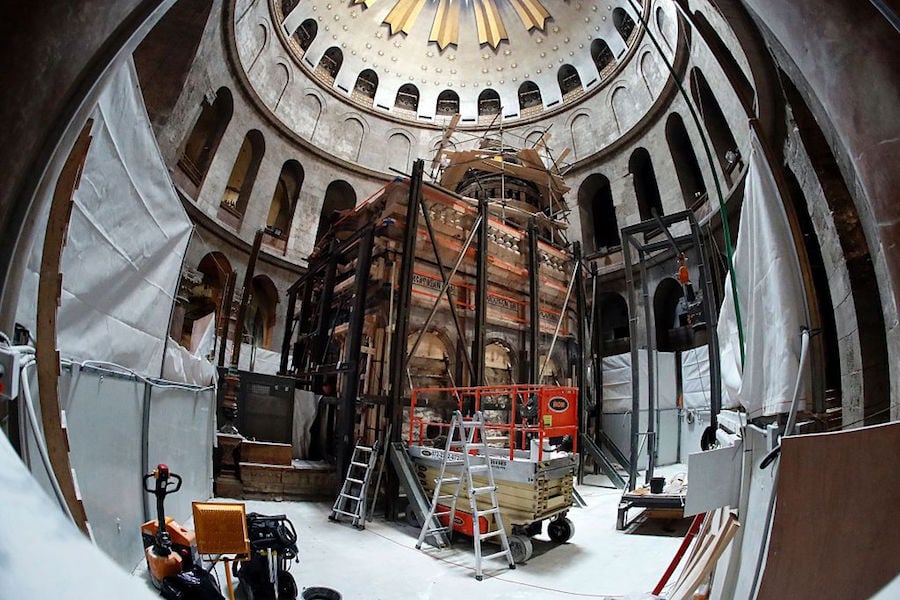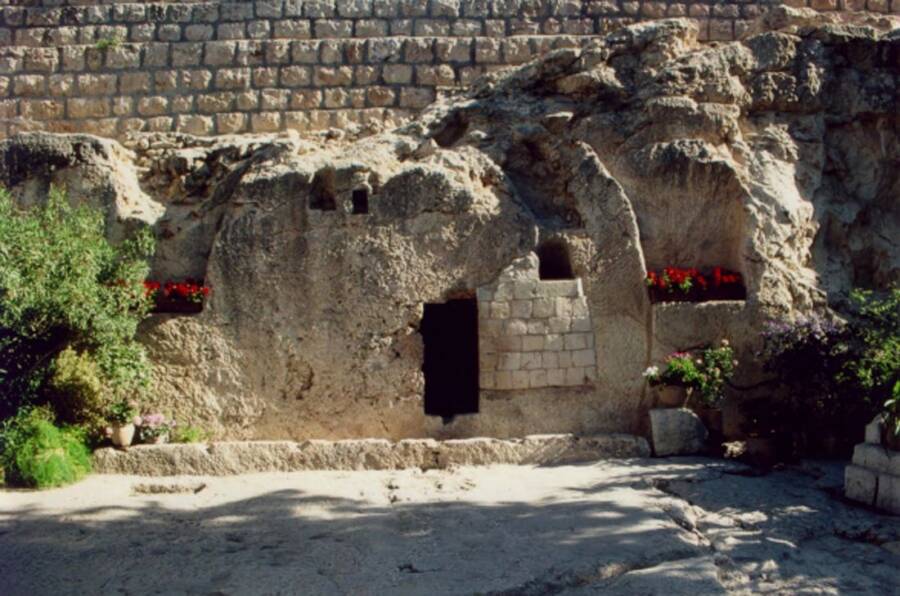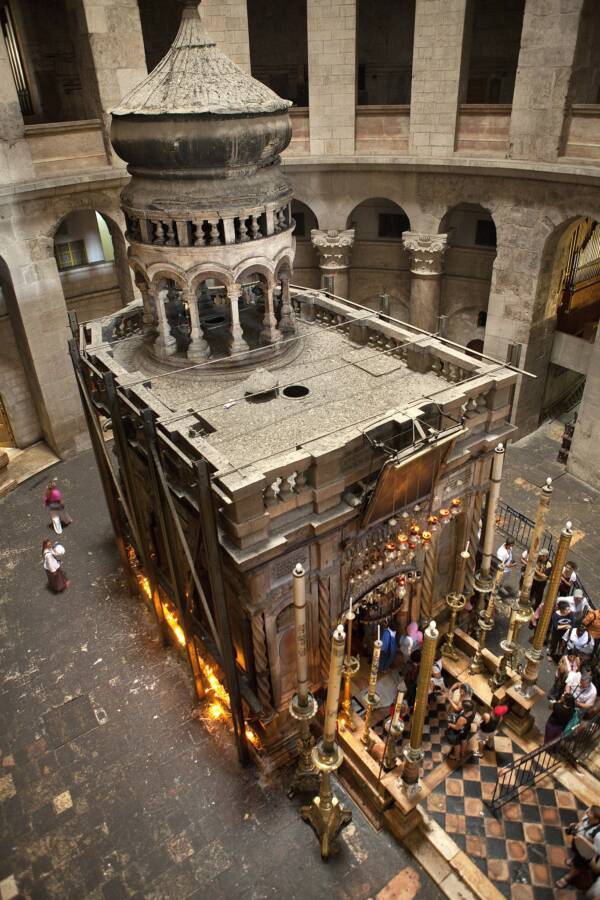After remaining sealed for centuries, the burial tomb of Jesus Christ at Jerusalem's Church of the Holy Sepulchre was briefly opened in 2016.

THOMAS COEX/AFP/Getty ImagesThe Aedicule (shrine) surrounding the Tomb of Jesus during the unsealing process.
According to the Bible, Jesus Christ was buried in a “tomb cut out of rock” just after his crucifixion at Golgotha. Three days later, he awed his followers when he walked out of the tomb alive. So, if it exists in the first place, where exactly is Jesus’ tomb?
The question has intrigued biblical scholars and historians for years. Could it be the Talpiot Tomb in Jerusalem? The Garden Tomb located nearby? Or even a burial plot in far-flung locations like Japan or India?
To date, most believe that the Church of the Holy Sepulchre in Jerusalem’s Old City is the likely location of Jesus’ tomb. And, in 2016, it was unsealed for the first time in centuries.
Why Many Think Jesus Was Buried At The Church Of The Holy Sepulchre
The belief that Jesus’ tomb is located at the Church of the Holy Sepulchre dates back to the fourth century. Then, the emperor Constantine — a recent convert to Christianity — ordered his representatives to find Jesus’ tomb.

israeltourism/Wikimedia CommonsThe exterior of the Church Of The Holy Sepulchre.
Upon arrival in Jerusalem in 325 A.D, Constantine’s men were directed to a 200-year-old Roman temple built by Hadrian. Beneath, they found a tomb made from a limestone cave, including a shelf or burial bed. This fit the description of Jesus’ tomb in the Bible, convincing them that they’d found his burial site.
Though the church has been widely recognized as the site of Jesus’ tomb ever since, it’s impossible to say for sure that Jesus Christ was buried there. Early Christians were persecuted and forced to flee Jerusalem, so they may have been unable to preserve his grave.
Muddying the waters is the fact that other likely tombs have appeared over the years. To some, the Garden Tomb in Jerusalem seems a likely candidate. Others believe that the Talpiot Tomb in the Old City could be Jesus’ tomb.
Both are cut from rock, just like the tomb in The Church Of The Holy Sepulchre. Yet many scholars say those tombs lack the church’s historical weight.

Wikimedia CommonsThe Garden Tomb was discovered in 1867.
“Although absolute proof of the location of Jesus’ tomb remains beyond our reach,” stated archaeologist John McRay, “the archaeological and early literary evidence argues strongly for those who associate it with the Church of the Holy Sepulchre.”
The Church Of The Holy Sepulchre has suffered over the centuries, however. It was sacked by Persians in the seventh century, destroyed by Muslim caliphs in the 11th century, and burned to the ground in the 19th century.
But each time it fell, Christians built it back. And, to date, many continue to believe that it’s the most likely site of Jesus’ tomb.
The tomb itself was sealed with marble cladding around 1555 to prevent visitors from taking pieces of stone. But in 2016, a crew of specialists opened it for the first time in centuries.
Inside The Tomb Of Jesus Christ
In 2016, the three entities that share the Church of the Holy Sepulchre — Greek Orthodox, Armenian Orthodox, and Roman Catholic — came to an agreement. Israeli authorities had declared the building unsafe and they would need to make repairs in order to keep it preserved.

israeltourism/Wikimedia CommonsA marble shine known as an Aedicule allegedly contains the tomb of Jesus Christ.
The powers that be summoned restorers from the National Technical University of Athens, who got to work in May. The restorers removed damaged mortar, repaired masonry and columns, and injected grout to hold everything together. By October, they realized they would need to open the tomb as well.
This came as a surprise. However, workers decided they would need to unseal the alleged tomb of Jesus to make sure that nothing leaked.
“We had to be very careful,” explained Harris Mouzakis, an assistant professor of civil engineering at National Technical University who helped restore the tomb.
“It was not just a tomb we had to open. It was the tomb of Jesus Christ that is a symbol for all of Christianity — and not only for them but for other religions.”
They carefully moved the marble cladding, and a second marble slab carved with a cross, to access the limestone cave beneath. Then, they were inside Jesus’ tomb.
For 60 hours, the team of restorers collected samples from the tomb, snapped rare photographs, and reinforced its walls. All the while, dozens of priests, monks, scientists, and workers took the opportunity to take a look inside the tomb of Jesus.
“We saw where Jesus Christ was laid down,” raved Father Isidoros Fakitsas, the superior of the Greek Orthodox Patriarchate, to The New York Times. “Before, nobody has.” (Nobody living today, that is.)
He added: “We have the history, the tradition. Now we saw with our own eyes the actual burial place of Jesus Christ.”
Others were equally awed by the experience. “I’m absolutely amazed. My knees are shaking a little bit because I wasn’t expecting this,” said Fredrik Hiebert, National Geographic‘s archaeologist-in-residence for the operation. National Geographic had exclusive access to the church restoration project.
Meanwhile, Peter Baker, who wrote about the unsealing for The New York Times, also had an opportunity to go inside the tomb of Jesus.
“The tomb itself looked plain and unadorned, its top separated down the middle,” Baker wrote. “The candles flickered, illuminating the small enclosure.”
After nine months and $3 million dollars worth of work, the restored and resealed tomb was revealed to the public. This time, workers left a small window in the marble so that pilgrims can see the limestone rock beneath. But whether they’re actually peering inside the tomb of Jesus may remain a mystery forever.
After reading about Jesus’ tomb, see why many think Jesus was white and what Jesus’ real name actually was and when he was born. Or, delve into the fascinating debate over who wrote the Bible. Then, learn about how old the Virgin Mary was when she had Jesus.





